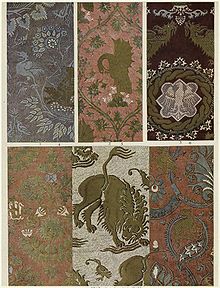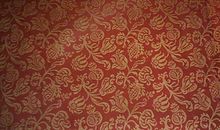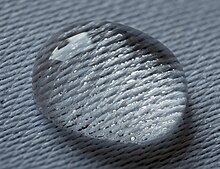Damask

Damask (/ˈdæməsk/; Arabic: دمشق) is a reversible patterned fabric of silk, wool, linen, cotton or synthetic fibers, with a pattern formed by weaving. Damasks are woven with one warp yarn and one weft yarn, usually with the pattern in warp-faced satin weave and the ground in weft-faced or sateen weave. Twill damasks include a twill-woven ground or pattern.[1][2]
History

The production of damask was one of the five basic weaving techniques—the others being tabby, twill, lampas, and tapestry—of the Byzantine and Middle Eastern weaving centres of the early Middle Ages.[3] Used in daily nomadic life this form of weaving was used generally as a female occupation, such as carpet-making. Women would collect the raw material from pasture animals and dyes from local flora such as berries, insects, or grasses. Each woman would create a specialized pattern sequence and use of color that was customary to her ethnic group and even herself. These techniques would often be handed down from mother to daughter as well.[4]
In China, drawlooms with a large number of heddles were developed to weave damasks with very complicated patterns.[5] The Chinese may have produced damasks as early as the Tang Dynasty (618-907).[6] Damasks derive their name from the city of Damascus—in that period a large city active both in trading (as part of the silk road) and in manufacture.[7] Damasks became scarce after the 9th century outside Islamic Spain, but were revived in some places in the 13th century.[3]
The word "damask" first appeared in records in a Western European language in the mid-14th century in French.[8] By the 14th century, damasks were being woven on draw looms in Italy. From the 14th to 16th century, most damasks were woven in one colour with a glossy warp-faced satin pattern against a duller ground. Two-colour damasks had contrasting colour warps and wefts and polychrome damasks added gold and other metallic threads or additional colours as supplemental brocading wefts. Medieval damasks were usually woven in silk, but weavers also produced wool and linen damasks.[2]
In the 19th century, the invention of the Jacquard loom which was automated with a system of punched cards, made weaving damask faster and cheaper.[5]
Modern usage

Modern damasks are woven on computerized Jacquard looms.[1] Damask weaves are commonly produced in monochromatic (single-colour) weaves in silk, linen or synthetic fibres such as rayon and feature patterns of flowers, fruit and other designs. The long floats of satin-woven warp and weft threads cause soft highlights on the fabric which reflect light differently according to the position of the observer. Damask weaves appear most commonly in table linens and furnishing fabrics but they are also used for clothing.[5] The damask weave is used extensively throughout the fashion industry due to its versatility and high-quality finish. Damask is usually used for mid-to-high-quality garments, meaning the label tends to have a higher definition and a more “expensive” look.
Rendering on Damask
Rendering a drawing on damask is a complex process based on precise techniques. The figure, such as a bird, or branch is drawn on millimetric paper, provided that its width does not exceed 5 cm in the case of being woven on a 400-hook loom where the shape is repeated every 5 cm or the width of the shape every 20 cm. The drawing is applied on cardboard on top of the loom which is called a Jacquard machine and it is movable in such a way that its movement is linked to hooks, and the important thing is to know the number of holes that occupy a square centimeter. When the loom is rotated, the shuttle of the ordinary threads passes as usual between the strands of all kinds. As for the shuttle specialized for golden threads, its passage raises hooks to the number of holes, and so on until the shape is completed, and then the work is repeated whenever the shape is repeated.[citation needed] These drawings used to be transferred with special hooks which were manually boiled.[clarification needed]
See also
- Diapering (damask patterns in heraldry)
References
- ^ a b Kadolph, Sara J., ed.: Textiles, 10th edition, Pearson/Prentice-Hall, 2007, ISBN 0-13-118769-4, p. 251
- ^ a b Monnas, Lisa. Merchants, Princes and Painters: Silk Fabrics in Italian and Northern Paintings 1300-1550. New Haven, Yale University Press, 2008, pp. 295–299
- ^ a b Jenkins, David T., ed.: The Cambridge History of Western Textiles, Cambridge, UK: Cambridge University Press, 2003, ISBN 0-521-34107-8, p. 343.
- ^ Mozzati, Luca (2019). Islamic Art: Architecture, Painting, Calligraphy, Ceramics, Glass, Carpets. Prestel. p. 61. ISBN 978-3-7913-8566-2.
- ^ a b c Gillow, John (1999). World Textiles: A Visual Guide to Traditional Techniques. Thames & Hudson. p. 82. ISBN 0-500-28247-1.
- ^ "A World of Looms: Weaving Technology and Textile Arts in China and Beyond". China National Silk Museum. Retrieved 11 September 2020.
- ^ "What is Damask Fabric", 9 February 2012 Period Home and Garden, accessed 2 March 2021
- ^ "Damas" etymology (in French). www.cnrtl.fr accessed 2 March 2021

